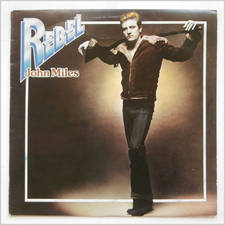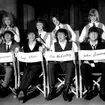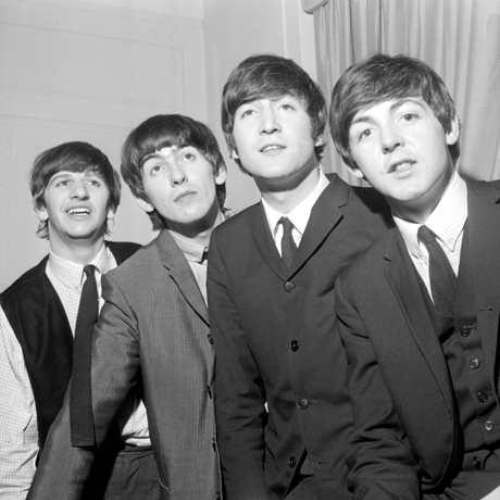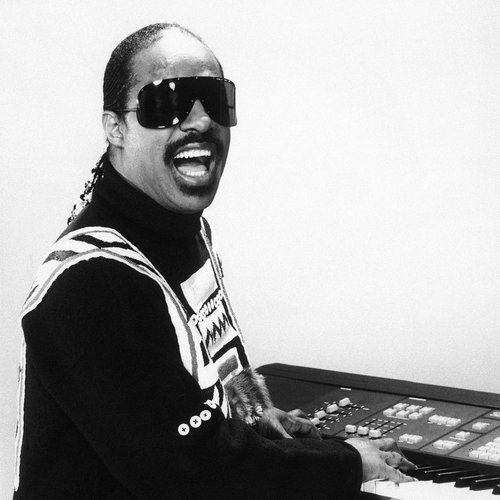'Glass Onion': The surreal Beatles song that gave Daniel Craig's Netflix movie its name
5 January 2023, 15:00 | Updated: 5 January 2023, 15:54

Good Ol’ Freda trailer – the Beatles secretary Freda Kelly
Daniel Craig's Knives Out sequel takes its name from the strange Beatles song, but how much do you know about John Lennon's quirky classic?
Listen to this article
Daniel Craig returned to the big screen small stream over the holidays in Glass Onion: A Knives Out Mystery.
The Netflix sequel sees the former James Bond actor reprise his role as Detective Benoit Blanc, and the title of Rian Johnson's murder mystery-meets-social satire immediately grabbed our attention.
- The Beatles vs The Rolling Stones – in their own words
- The story behind The Beatles last ever live performance
- Listen to the Gold 60s Live Playlist on Global Player
That's because the film's name – and more than a little of its cryptic nature – is borrowed from The Beatles song, which also features over the movie's end credits.
'Glass Onion' is the third track on 1968's The Beatles, the record we all know as The White Album, and it comes in on the heels of the rocking opener 'Back in the USSR' and the more contemplative 'Dear Prudence'.
Written and sung by John Lennon, 'Glass Onion' is the most self-referential song by the band.

The Beatles - Glass Onion (2018 Mix)
It's one that takes the mickey out of critics and fans who loved to pore over every last word by the Fab Four, while simultaneously inviting us to do just that.
Before we blather on, it's worth asking: what the hell is a glass onion? Is it just a fantastical Lennon flight of fancy?
Actually, a glass onion is a hand-blown glass bottle, often used on sailing ships for holding wine or brandy.
It's a great visual image though, a fragile, semi-transparent object filled with both intoxication and – perhaps – layered meaning.

So it goes, after Paul McCartney's relatively minor moped crash in November 1966, rumours swirled that Paul Is Dead, and that he was replaced by an impersonator (some say the fictional "Billy Shears" of Sgt Pepper's Lonely Heart's Club Band).
There were supposedly countless "clues" about "the truth" littered over The Beatles' records after the incident, all of which were frankly ridiculous.
By the time of The White Album, The Beatles were well aware of the Paul Is Dead nonsense, as well as the over-analysis of their work, and John especially was happy to play with all of that in his typically arch and contrary way.

The Making Of Glass Onion
Like all Beatles songs to that date, 'Glass Onion' was produced by George Martin, with engineering by Ken Scott – the man who would go on to co-produce some of David Bowie's best-known work.
John's powerhouse vocals grab your attention from the off, as does the intentionally messy mix of instruments and styles, but it's the lyrics that have made the song one of the most discussed Beatles album tracks.
The song directly references a whopping FIVE other Beatles songs, all of which were released in the last 18 months
- "I told you about strawberry fields / You know the place where nothing is real – 'Strawberry Fields Forever' (1967 single)
- "I told you about the walrus and me, man" – 'I Am The Walrus' (1967 single)
- "Lady Madonna trying to make ends meet, yeah" – 'Lady Madonna' (1968 single)
- "I told you about the fool on the hill" – 'The Fool on The Hill' (from 1967 EP/album Magical Mystery Tour)
- "Fixing a hole in the ocean" – 'Fixing A Hole' (from 1967 album Sgt Pepper's Lonely Heart's Club Band)

I Am The Walrus
If thing's weren't layered enough, it's worth noting that two of these songs already referenced other Beatles songs themselves.
'Lady Madonna' has a nod to 'I Am The Walrus' ("see how they run"), while 'I Am The Walrus' referenced 'Lucy in the Sky With Diamonds' ("see how they fly like Lucy in the sky").
The self-references weren't just lyrical. After that line about 'The Fool on the Hill', Paul plays a snatch of that song's melody on the recorder to underline the point.
(On the Love remix/mashup version of 'Glass Onion', George and Giles Martin even snuck in a sample of 1964 B-Side 'The Things We Said Today')

Glass Onion
As quoted in the chunky Anthology book, John Lennon was pretty dismissive about the whole thing in his 1980 Playboy interview.
"That's me, just doing a throwaway song, à la 'Walrus', à la everything I've ever written," he claimed.
"I threw the line in – 'the Walrus was Paul' – just to confuse everybody a bit more. It could have been: 'The fox terrier is Paul'. I mean, it's just a bit of poetry. I was having a laugh because there'd been so much gobbledegook about Pepper – play it backwards and stand on your head and all that.

Did Paul McCartney really die in 1966? The history of the conspiracy theory | Vinyl Rewind
"At that time I was still in my love cloud with Yoko. I thought, 'Well, I'll just say something nice to Paul, that it's all right and you did a good job over these few years, holding us together'. He was trying to organise the group and all that, so I wanted to say something to him. I thought, 'Well, he can have it I've got Yoko. And thak you, you can have the credit'."
"The line was partly put in because I was feeling guilty because I was with Yoko and I was leaving Paul. It's a very perverse way if saying to Paul: 'Here, have this crumb, this illusion, this stroke – because I'm leaving'."

The Fool On The Hill
As for the rest of the lyrics, we'd caution against trying too hard to interpret them accordingly
Nevertheless, we think that Lennon protested too much about how "throwaway" 'Glass Onion' – and all of his work with The Beatles – actually was.
For what it's worth, The Cast Iron Shore, known by locals as The Cazzy, was a nickname for the rubbish-filled banks of the Mersey, so earned due to the nearby presence of an iron foundry.
The Beatles press officer Derek Taylor explained that the "bent-back tulips" were spotted by John at a posh restaurant.

Dove-tailed joints are nothing to do with drugs (well, not originally), but instead the name of a commonly used carpentry method.
It's worth noting that the lyrics – scrawled by Lennon on the back of an envelope – show that this reference was swapped in later in the day.
The original line was "Fixing a hole in the ocean / For a yellow submarine". Maybe even John thought that was one reference too many.
Neither lyric appears on the embryonic Home Demo version on Anthology 3, which had been recorded on May 8, 1968 at George Harrison's home at Kinfauns in Esher.

Glass Onion (Demo / Anthology 3 Version)
The Beatles started recording 'Glass Onion' on September 11 at Abbey Road, a week after Ringo Starr returned to the band following his 13-day departure from the group, which had been kept secret from the world at the time.
They continued to work on it over the following days, adding drums and piano on September 13, with further overdubs on September 16.
John made a tape of sound effects for 'Glass Onion' on September 26 that didn't actually get used, but you can hear some of it on Anthology 3's 'Take 33' version of the song, which features the sound of breaking glass and "It's a goal" commentary.
The track was eventually finished off on October 10, a month and a half before The Beatles was released on November 22.

Glass Onion (Take 33 / Anthology 3 Version)
Recorded in A minor and C major, the finished song has the same mix of oddball gaiety and slight menace as its spiritual predecessor 'I Am The Walrus'.
It features double-tracked lead vocals and acoustic guitar from John, George Harrison on lead guitar, Ringo on drums and tambourine, and Paul on bass, piano and recorder
Filling out the sound is a string section made up of Henry Datyner, Eric Bowie, Norman Lederman and Ronald Thomas on violins, John Underwood and Keith Cummings on violas, and Eldon Fox and Reginald Kilbey on cellos.






















